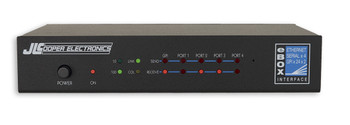Description
eBOX GPI8
Ethernet IP/GPI Interface
8 Opto-Isolated Inputs/8 Relay Outputs
eBOX GPI8 is a portal for controlling devices across your facility or across the world. It's a general purpose interface that converts 8 GPI inputs and outputs to 10/100 Ethernet. For compatibility, it uses the same messages as the original eBOX and it's fully compatible with eBOX and sBOX. Think of it as a simpler eBOX without the serial ports, with eBOX IO functionality built in.
Detachable Weidmüller terminal block connectors provide 8 optically-isolated GPI Inputs and 8 dry relay outputs. It includes parallel CMOS level GPI inputs with internal pull-ups to +5volts and GPI output ports on 25 pin Dsub connectors. It's ideal for LAN, WAN and Internet control with switchers, computer based systems, cameras, monitors, projectors and other devices.
eBOX GPI8 is the perfect solution for broadcast television, streaming media networks, multi-room editing facilities, news production or in any audio/ video/multimedia studio where remote hosts need to control devices with GPI and Tally over long distances, or via the Internet.
It simplifies long distance control by using IP addressable, point-to-point architecture to send GPI messages over existing 10/100 BASE-T wiring. Host to eBOX, eBOX to host, or eBOX to eBOX communication is possible.
It communicates using standard TCP/IP. Traffic can be routed over internal LANs, wireless LANs, MANs, WANs and over the Internet.
Configuration is accomplished through a provided Windows application. Parameters such as port speed, parity, IP address, remote IP address and TCP port are set. Settings are stored in nonvolatile memory.
When eBOXes establish a connection, both client and server will send the state of its GPI In ports to each other so it can be shown on the GPI Output port on the remote eBOX. After that, only changes to a GPI In port will cause an eBOX to send a GPI message to the remote
It supports IEEE 802.3u clause 28 Auto-Negotiation which automatically senses the Ethernet port speed & duplex operation and chooses the highest performance settings. Front panel LEDs indicate GPI and Ethernet status.
The unit functions as a server, passively waiting for client devices to connect to it. The device can be a computer or another eBOX configured as a client. When the eBOX is configured as a client, it will actively attempt to connect to the server eBOX. Once accomplished, eBOX will then pass data received in the serial or GPI ports to the remote eBOX. If there is no data received, eBOX will not send any TCP packets.
Physical connections are easily accomplished using supplied high density, removable, terminal block screw connectors with 8 opto-isolated, inputs. The GPI output connector has 8 electrically isolated dry relay outputs.
Parallel CMOS level GPI inputs with internal pull-ups to +5 volts and GPI output ports are available on 25 pin D-sub connectors.
JLCooper's Developer Documentation provides comprehensive tools for software developers to link Visual Basic, C++ or embedded devices for direct control of any device connected to any eBOX.










